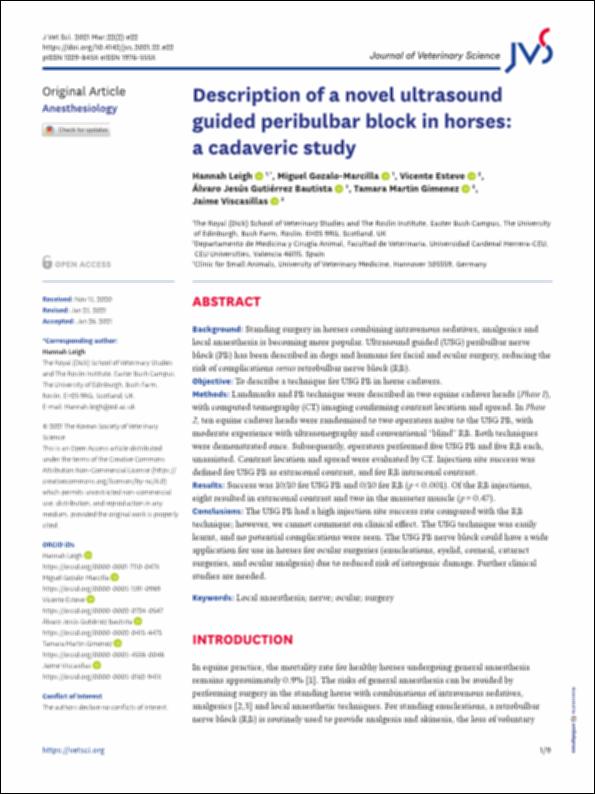Por favor, use este identificador para citar o enlazar este ítem:
http://hdl.handle.net/10637/13455Description of a novel ultrasound guided peribulbar block in horses : a cadaveric study
| Título : | Description of a novel ultrasound guided peribulbar block in horses : a cadaveric study |
| Autor : | Leigh, Hannah Gozalo Marcilla, Miguel Esteve Bernet, Vicente Gutiérrez Bautista, Álvaro Jesús Martín Giménez, Tamara Viscasillas Monteagudo, Jaime |
| Materias: | Horses - Surgery.; Caballos - Ojos - Enfermedades.; Horses - Eyes - Diseases.; Caballos - Anestesia.; Local anesthesia.; Caballos - Cirugía.; Anestesia veterinaria.; Veterinary anesthesia.; Anestesia local.; Horses - Anesthesia. |
| Editorial : | The Korean Society of Veterinary Science |
| Citación : | Leigh, H., Gozalo-Marcilla, M., Esteve, V., Gutiérrez Bautista, Á.J., Martin Gimenez, T. & Viscasillas, J. (2021). Description of a novel ultrasound guided peribulbar block in horses : a cadaveric study. The Journal of Veterinary Science, vol. 22, i. 2 (05 mar.), art. e22. DOI: https://doi.org/10.4142/jvs.2021.22.e22 |
| Resumen : | Background: Standing surgery in horses combining intravenous sedatives, analgesics and local anaesthesia is becoming more popular. Ultrasound guided (USG) peribulbar nerve block (PB) has been described in dogs and humans for facial and ocular surgery, reducing the risk of complications versus retrobulbar nerve block (RB). Objective: To describe a technique for USG PB in horse cadavers. Methods: Landmarks and PB technique were described in two equine cadaver heads (Phase 1), with computed tomography (CT) imaging confirming contrast location and spread. In Phase 2, ten equine cadaver heads were randomised to two operators naïve to the USG PB, with moderate experience with ultrasonography and conventional “blind” RB. Both techniques were demonstrated once. Subsequently, operators performed five USG PB and five RB each, unassisted. Contrast location and spread were evaluated by CT. Injection site success was defined for USG PB as extraconal contrast, and for RB intraconal contrast. Results: Success was 10/10 for USG PB and 0/10 for RB (p < 0.001). Of the RB injections, eight resulted in extraconal contrast and two in the masseter muscle (p = 0.47). Conclusions: The USG PB had a high injection site success rate compared with the RB technique; however, we cannot comment on clinical effect. The USG technique was easily learnt, and no potential complications were seen. The USG PB nerve block could have a wide application for use in horses for ocular surgeries (enucleations, eyelid, corneal, cataract surgeries, and ocular analgesia) due to reduced risk of iatrogenic damage. Further clinical studies are needed. |
| Descripción : | Este artículo se encuentra disponible en la siguiente URL: https://vetsci.org/pdf/10.4142/jvs.2021.22.e22 |
| URI : | http://hdl.handle.net/10637/13455 |
| Derechos: | http://creativecommons.org/licenses/by-nc/4.0/deed.es |
| ISSN : | 1229-845X 1976-555X (Electrónico) |
| Fecha de publicación : | 5-mar-2021 |
| Centro : | Universidad Cardenal Herrera-CEU |
| Aparece en las colecciones: | Dpto. Medicina y Cirugía Animal |
Los ítems de DSpace están protegidos por copyright, con todos los derechos reservados, a menos que se indique lo contrario.


